International Journal of Engineering and Manufacturing @ijem
Статьи журнала - International Journal of Engineering and Manufacturing
Все статьи: 550
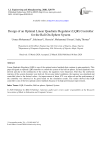
Design of an Optimal Linear Quadratic Regulator (LQR) Controller for the Ball-On-Sphere System
Статья научная
Linear Quadratic Regulator (LQR) is one of the optimal control methods that continue to gain popularity. This paper designed an optimal LQR controller to control the system of the ball-on-sphere. System equations were derived and due to the nonlinearity of the system, the equations were linearized. After that, the coefficient matrices of the system dynamics were derived. Given some initial conditions, the response was simulated and controlled close to the desired values. An improvement of about 87% was achieved and the performance of the controller was observed to be good based on the simulation results. The results showed that LQR controller is one of the best optimal control methods because of its high performance improvement.
Бесплатно

Design of the Wing of a Medium Altitude Long Endurance UAV
Статья научная
Over time, the need to extend the endurance of fixed-wing UAVs has been a challenge and requirement for the aviation industry. As a result, there are many ongoing researches on how to address this challenge while developing new concepts for an aircraft wing. This paper presents the methodology applied in the design of the wing of a lightweight unmanned aerial vehicle (UAV) that is intended for intelligence and surveillance (ISR) missions. A conceptual design was developed with the aircraft having a hybrid wing for the purpose of improving its structural design. The wing has two spars and thirteen ribs a side with an all-composite structure. Initial calculations were performed theoretically, thereafter, analyzed using the finite element analysis tool.
Бесплатно
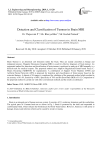
Detection and classification of tumour in brain MRI
Статья научная
Brain Tumour is an abnormal cell formation inside the brain. They are mainly classified as benign and malignant tumours. Magnetic Resonance Imaging (MRI) is used for effective diagnosis of brain tumour. An automated method for detection and classification of brain tumour is preferred as analysis of MRI manually is a difficult task for medical experts. The proposed method uses Adaptive Regularized Kernel based Fuzzy C-Means Clustering (ARKFCM) for segmentation. A combination of Support Vector Machine (SVM) and Artificial Neural Network (ANN) is proposed for detection and classification of brain tumour based on the extracted features. A dataset of 94 images is considered for validation of the proposed method which resulted in an accuracy of 91.4%, Sensitivity of 98%, Specificity of 78% and Bit Error Rate (BER) of 0.12. Comparison of the proposed method is carried out with other conventional methods and the results are tabulated.
Бесплатно
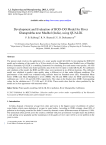
Development and Evaluation of BOD–DO Model for River Ghataprabha near Mudhol (India), using QUAL2K
Статья научная
The present study involves the application of a water quality model QUAL2K for developing the BOD-DO model and evaluation of the results for a 50 km stretch of river Ghataprabha near Mudhol town of Bagalkot district, Karnataka. QUAL2K is a modeling framework for simulating river and stream water quality. Arc-GIS technique is used to obtain some hydro-geometric data of the river for input to model QUAL2K. For calibration and validation of the model, the BOD and DO values were monitored at six different locations. The calibrated model was validated to predict water quality using a different set of data under different conditions. The performance of the model was evaluated using statistics based on Standard errors (SE), Normalized Mean Errors (NME) and Mean Multiplicative errors (MME). The SE and MME values for BOD and DO during calibration are, 1.41 (1.12) and1.28 (0.90), respectively. The values in the bracket show MME. Corresponding values for the validation are 1.27 (1.09) and 1.10 (0.96). These results show that the values predicted by the model are in close agreement with measured values.
Бесплатно
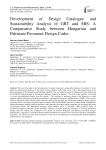
Статья научная
The aim of the paper is the development of a design catalog and sustainability analyses of road layers. In this paper, the material and thickness of the layers for three different traffic load classes will be determined based on the pavement design of the Hungarian and Pakistani standards. This was achieved using the Hungarian design method and the AASHTO method adopted by the National Highway Authority in Pakistan. "This will enable engineers in the field to choose pre-established designs from the catalog.". The forefront of pavement design is the direction in which ongoing research endeavors in the field are guiding us. The empirical design, as outlined in the AASHTO 1993 version, relies on statistical models derived from road tests. Moving beyond this, the mechanistic-empirical design involves assessing stresses and strains alongside empirical models, such as the MEPDG approach. Looking ahead, a mechanistic design encompasses models based on mechanics and represents the frontier where researchers are advancing the future of pavement design. The Hungarian pavement design method (eÚT 2-1.202:2005, 2005) primarily relies on mechanistic-empirical pavement design principles. However, it limits practicing engineers to choosing predefined designs from the catalog. The Comparison was carried out between Hungarian and Pakistani pavement designs. Subsequently, comparative calculations between GRT and SBS will be made for CO2 emissions and other sustainability parameters. To achieve this aim, the Pavement LCA tool by the US Department of Transportation Federal Highway Administration was employed.
Бесплатно
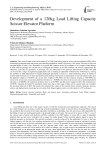
Development of a 120kg Load Lifting Capacity Scissor Elevator Platform
Статья научная
This work focused on the development of a 120kg load lifting capacity scissor elevator platform (SEP) with a horizontally positioned rack and pinion gear actuating mechanism which is driven by a DC motor. The time of lift to an elevated height of 0.9m is 30s. Simulation of a typical SEP structure in the 3D workspace of a Computer Aided Design (CAD) software package was carried out to investigate the balance of the SEP structure, the stresses experienced, the efficiency, and safety of operations. A prototype was also fabricated for the physical demonstration of SEP. The SEP can be used for a range of engineering applications such as making an adjustable workbench for workshop use, solving the problem of table adjustment for height-challenged personnel, or used as a load-transferring device if mobile to transfer loads between two or more elevated locations during construction or maintenance work. Calculated results give the platform weight as 136.693N, the scissor arms weight as 188.205N, the total structure weight as 1502.098N, the stress in the scissor arm at maximum platform elevation as 1.702MPa, the stress in the scissor arm at minimum platform elevation as 4.928MPa, the maximum actuation force as 4126.980N, and the power required to drive the mechanism as 26.963W. Autodesk Inventor Pro simulation results show that a wide range of data can be sourced when one considers the real-time behavior of SEP. The results also indicated the values of the reaction forces, reaction moments, stresses, strains, and displacements developed at every joint, link, hinged support, and every other point in a 3D workspace.
Бесплатно

Development of a Brain Tumour Detection and Classification Model with Web Application Capability
Статья научная
In the evolving landscape of medical imaging, this study introduces a deep learning-based approach for brain tumour detection and classification. In this study, a U-Net architecture was developed for tumour detection and segmentation while an EfficientNet-based model was used for classification. Dataset consisting of MRI scans which has complex brain tumour pattern types was used to train the model. The performance of the developed model was evaluated using Dice coefficient, IoU score, sensitivity, and specificity for detection, and accuracy, precision, recall, and F1-score for classification, which demonstrates the system's effectiveness. The detection model achieves a Dice coefficient of 0.9321 and an IoU score of 0.8729, while the classification model attains an overall accuracy of 0.965, which surpasses the benchmark methods. Additionally, a user-friendly web interface was developed to enhance the system's practicality for clinical use. The results obtained show that the developed interface enables real-time tumour analysis. The proposed system not only improves the accuracy and efficiency of brain tumour analysis but also provides a seamless tool for medical professionals, which will enhance diagnostic workflows and patient outcomes.
Бесплатно
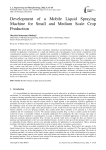
Development of a Mobile Liquid Spraying Machine for Small and Medium Scale Crop Production
Статья научная
This article presents the design, simulation, fabrication and performance evaluation of a liquid spraying machine for application of pesticides in a small and medium scale crop plantation. In this article, components of the conceptualized spraying machine were modelled and assembled in SolidWorks CAD environment. The modelled components were designed in order to obtain design parameters for simulation. An extensive simulation on the stress and strain analysis was carried out on the designed components. The significance of the simulation is to predict the structural integrity and performance of the component parts of the machine before fabrication. The components were fabricated from locally sourced material in order to ensure a lower cost of production. The fabricated spraying machine was tested and the performance indicated that a field efficiency of 79% is obtainable in an average time of 1374 s to spray a maize crop field area of 1813 m2 having an average crop height of 0.52m. Further observations from the performance analysis also show that the field efficiency of the spraying machine drops to a value of 75% when used in a crop field area of 2206.3 m2. This is an indication that the spraying machine’s efficiency will reduce as the field area increases. In essence, the significance of the approach presented in this article is to ensure that the simulation predicts the performance of the design and the fabrication of the spraying machine using locally sourced material will ensure lower cost of fabrication.
Бесплатно
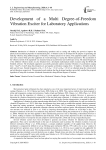
Development of a Multi Degree-of-Freedom Vibration Exciter for Laboratory Applications
Статья научная
Introduction of vibration to manufacturing operations such as casting and welding has proved to improve the physical and mechanical properties of manufactured parts. A vibration exciter is developed for the purpose of generating and inducing vibration, along different degrees of freedom, on objects placed on its surface. The equipment applies an eccentric mass drive system which gives the equipment an overall advantage in varying the vibration parameters. The acceleration of the vibratory motion of the equipment was measured using an accelerometer and oscilloscope set-up. The natural frequencies of the different vibration modes are also obtained from a developed mathematical model executed using the MATLAB Simulink software. The developed equipment successfully generated random sinusoidal vibrations of accelerations ranging from −5 m/s^2 to 8 m/s^2 along the principal axes and angular accelerations ranging from −40 rad/s to 40 rad/s about the pitch and roll axes. Natural frequencies of f_x = 3.78 Hz, f_θ = 7.94 Hz and f_φ = 9.89 Hz are obtained along the vertical, pitch and roll directions respectively. The presented results indicate that the developed machine successfully satisfied the proposed hypothesis of being able to measure vibrational characteristics along different degrees of freedom.
Бесплатно
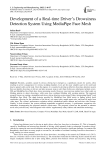
Development of a Real-time Driver’s Drowsiness Detection System Using MediaPipe Face Mesh
Статья научная
Recently, accidents caused by drowsy driving have emerged as a significant concern for society, often resulting in severe consequences for victims, including fatalities. Lives are the most valuable asset in the world and deserve greater safety on the road. Given the urgency, it is essential to develop an effective drowsiness detection system that can identify drowsiness in drivers and take necessary steps to alert them before any unfortunate incident occurs. Dlib and MediaPipe Face Mesh have shown promising results. However, most previous studies have relied solely on blinking patterns to detect drowsiness, while some have combined blinking with yawning patterns. The proposed research focuses on creating a straightforward drowsy driver detection system using Python, incorporating OpenCV and MediaPipe Face Mesh. The shape detector provided by MediaPipe Face Mesh assists in finding critical facial coordinates, allowing for the calculation of the driver's eye aspect ratio, mouth aspect ratio, and head tilt angle from video input. The system's performance evaluation utilizes standardized public datasets and real-time video footage. Notably, in both scenarios, the system exhibited remarkable recognition accuracy. A performance comparison was undertaken, demonstrating the proposed method's effectiveness. The proposed system has the potential to enhance travel safety and efficiency when integrated with vehicles' supplementary safety features and automation technology.
Бесплатно
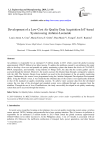
Development of a low-cost air quality data acquisition IoT-based system using arduino leonardo
Статья научная
Air pollution is responsible for an estimated 5.5 million deaths in 2013 which costed the global economy approximately US$225 billion in lost labor income. To address the problems caused by air pollution, this study aims to develop a low-cost and portable air quality monitoring system that detects the levels of CO, PM2.5, PM10, temperature, and humidity. Using Internet of Things (IoT), the data that the system gathers can be accessed through the internet. Moreover, the system assesses the obtained data through a comparative analysis with the AQI. The Iterative Design Loop method was used in the development of the air quality monitoring system. Furthermore, the sensors were programmed using the Arduino Integrated Development Environment (IDE). Using the Welch’s t-test, it was found that the obtained data of the system is not significantly different to that of the standard air quality monitoring systems. To achieve more accurate data from the developed system, the raw data of the developed and standard system were calibrated through an equation from the trendline. Through the use of Acer CloudProfessor, the study successfully developed an air quality monitoring system that can be accessed through the internet.
Бесплатно
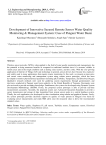
Статья научная
Wireless sensor networks (WSN), when applied to the field of water quality monitoring and management, has the potential to bring numerous benefits as compared to traditional methods since it is accurate, reliable in remote areas and in the tough condition such as during rainy seasons, and less costly. With the ever-growing application of Internet of Things (IoT) and technology in general, sensor devices have become less expensive and widely used in many applications that require remote monitoring. In this work, we present an innovative and secure water monitoring and management system using remote sensor prototype, which has been developed to monitor physiochemical parameters including pH, Turbidity, Temperature, and Dissolved Oxygen. Qualitative research methods were used for gathering system requirements through questionnaires and interviews conducted in Pangani water basin authority, in the United Republic of Tanzania. Documents were also reviewed to provide secondary knowledge. Furthermore, the system was developed using Dynamic System Development Methodology (DSDM). Firstly, the proposed system prototype is able to provide real-time measurements accurately. Secondly, the proposed system uses Advanced Encryption Standards to provide a secure transmission and storage of data transmitted from remote sensor nodes to a central database system. Thirdly, the web application was developed for data visualization using tabular and graphical formats. Lastly, the system prototype provides decisions support on quality of water present in Pangani river basin by evaluating sensor measurements and sends SMS alerts once the measured value is above the recommended standard values.
Бесплатно

Development of machine vision system for automatic inspection of vehicle identification number
Статья научная
The vision system is developed to reduce the human effort and improve productivity in the Vehicle Quality Assurance (VQA) shop for inspection of a car bearing a Vehicle Identification Number (VIN), assigned to it at the assembly shop. This project work is carried out in association with M/s Renault Nissan Automotive India Pvt Ltd, Chennai. The vision system consists of a camera fixed on a pan-tilt camera frame and an Optical Character Recognition (OCR) software. The camera frame is mounted on a belt conveyor with remote control of forward, backward and tilting motion. The image of VIN present at the car door is captured through a digital camera placed adjacent to the car. The characters in the VIN image thus obtained are extracted using MATLAB, with configurable OCR software. Template matching method is followed in the OCR process. The MATLAB code can overcome trivial issues in VIN image inspection at the quality shop. Development of a graphic user interface to the software is also described.
Бесплатно
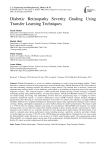
Diabetic Retinopathy Severity Grading Using Transfer Learning Techniques
Статья научная
Diabetic Retinopathy is a severe eye condition originating as a result of long term diabetes mellitus. Timely detection is essential to prevent it from progressing to more advanced stages. Manual detection of DR is labor-intensive and time-consuming, requiring expertise and extensive image analysis. Our research aims to develop a robust and automated deep learning model to assist healthcare professionals by streamlining the detection process and improving diagnostic accuracy. This research proposes a multi-classification framework using Transfer Learning for diabetic retinopathy grading among diabetic patients. An image based dataset, APTOS 2019 Blindness Detection, is utilized for our model training and testing. Our methodology involves three key preprocessing steps: 1) Cropping to remove extraneous background regions, 2) Contrast enhancement using CLAHE (Contrast Limited Adaptive Histogram Equalization) and 3) Resizing to a consistent dimension of 224x224x3. To address class imbalance, we applied SMOTE (Synthetic Minority Over-sampling Technique) for balancing the dataset. Data augmentation techniques such as rotation, zooming, shifting, and brightness adjustment are used to further enhance the model's generalization. The dataset is split to a 70:10:20 ratios for training, validation and testing. For classification, EfficientNetB3 and Xception, two transfer learning models, are used after fine-tuning which includes addition of dense, dropout and fully connected layers. Hyper parameters such as batch size, no. of epochs, optimizer etc were adjusted prioir model training. The performance of our model is evaluated using various performance metrics including accuracy, specificity, sensitivity and others. Results reveal the highest test accuracy of 95.16% on the APTOS dataset for grading diabetic retinopathy into five classes using the EfficientNetB3 model followed by a test accuracy of 92.66% using Xception model. Our top-performing model, EfficientNetB3, was compared against various state-of-the-art approaches, including DenseNet-169, hybrid models, and ResNet-50, where our model outperformed all these methodologies.
Бесплатно
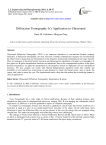
Diffraction Tomography: It's Application in Ultrasound
Статья научная
Ultrasound Diffraction Tomography (UDT) is an important alternative to conventional B-mode imaging. Generally, in diffraction tomography, the most universal available computational strategies for reconstructing the object from its projections are interpolation in the frequency domain and interpolation in the space domain. They are analogous to the direct Fourier inversion and backprojection algorithms of straight ray tomography. In this paper two B-spline interpolation functions are introduced. Due to the computational expenses in the space domain interpolation, we apply the interpolation in the frequency domain to implement our new interpolation functions. We also compare our results with filtered backprojection algorithm result. The validity and feasibility of our method was tested using an agar phantom to mimic the human tissue, olive to mimic the cancer, and water to mimic the cyst. The experimental results show that this method has a promising impact in clinical applications.
Бесплатно
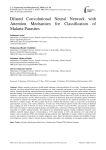
Статья научная
Malaria remains a pervasive global health challenge, affecting millions of lives daily. Traditional diagnostic methods, involving manual blood smear examination, are time-consuming and prone to errors, especially in large-scale testing. Although promising, automated detection techniques often fail to capture the intricate spatial features of malaria parasites leading to inconsistent performance. In order to close these gaps, this work suggest an improved technique that combines a Self-Attention Mechanism and a Dilated Convolutional Neural Network (D-CNN) to allow the model to effectively and precisely classify malaria parasites as infected or uninfected. Both local and global spatial information are captured by dilated convolutions, and crucial features are given priority by the attention mechanism for accurate detection in complex images. We also examine batch size variation and find that it plays a crucial role in maximizing generalization, accuracy, and resource efficiency. A batch size of 64 produced superior results after testing six different sizes, yielding an AUC of 99.12%, F1-Score of 96, precision of 97.63%, recall of 93.99%, and accuracy of 96.08%. This batch size balances efficient gradient updates and stabilization, reducing overfitting and improving generalization, especially on complex medical datasets. Our approach was benchmarked against existing competitors using the same publicly available malaria dataset, demonstrating a 2-3% improvement in AUC and precision over state-of-the-art models, such as traditional CNNs and machine learning methods. This highlights its superior ability to minimize false positives and negatives, particularly in complex diagnostic cases. These advancements enhance the reliability of large-scale diagnostic systems, improve clinical decision-making, and address key challenges in automated malaria detection.
Бесплатно
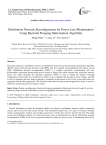
Статья научная
This paper presents a distribution network reconfiguration based on bacterial foraging optimization algorithm (BFOA) along with backward-forward sweep (BFS) load flow method and geographical information system (GIS). Distribution network reconfiguration (DNR) is a complex, non-linear, combinatorial, and non-differentiable constrained optimization process aimed at finding the radial structure that minimized network power loss while satisfying all operating constraints. BFOA is used to obtain the optimal switching configuration which results in a minimum loss, BFS is used to optimize the deviation in node voltages, and GIS is used for planning and easy analysis purposes. Simulation is performed on the 33-bus system and results are compared with the other approaches. The obtained results show that the proposed approach is better in terms of efficiency and having good convergence criteria.
Бесплатно
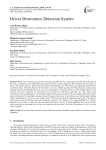
Driver Drowsiness Detection System
Статья научная
When you are driving a car and you are being responsible for your co-passenger and other innocent being on the road, you should be extra responsible. Many fatal and minor accidents happen on the road due to the drowsiness of drivers only. Hence, there is a need to detect drowsiness while driving a car. It has become an important requirement for everyone’s safety. The main objective of this study is to create a highly accurate drowsiness detection system using methods that are both affordable and easy for any car manufacturer to include in their cars. The ultimate objective is to increase road user’s protection by raising the level of safety for both drivers and their cars. This study's main contribution is the implementation of a bimodule method for drowsiness detection. The first module effectively detects signs of drowsiness by analyzing a constant stream of images of the driver in real time using a reinforcement learning model. Simultaneously, the car's second module, which is built into the steering wheel grip, keeps track of the driver's hand pressure when performing turns and emergency scenarios. The findings of the study highlight how well the proposed system works to reduce the risks associated with drowsy driving. It further highlights the value of cutting-edge technology in protecting other drivers and improving driving safety, which has the potential to save lives and avoid accidents.
Бесплатно
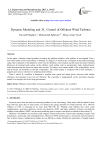
Dynamic Modeling and H∞ Control of Offshore Wind Turbines
Статья научная
In this paper, vibration control problem in tension leg platform offshore wind turbines is investigated. First a non-linear model of the wind turbine is obtained. Six degrees of freedom are considered in the model including surge, heave and pitch of the platform, tower fore-aft vibrations, rotor rotation and drivetrain torsional vibration. Moreover all external loads acting on the offshore wind turbine such as aerodynamic loads, hydrodynamic loads and mooring line forces are taken into account. To achieve an accurate model of the wind turbine, tower and drivetrain are modelled as flexible components. The model output is compared with FAST simulator; a popular open source software for modeling wind turbines. Then, a robust controller is designed to regulate rotor speed and output power, increase wind turbine efficiency and attenuate tower fore-aft vibration. The controller is implemented on the non-linear dynamic model to investigate the closed loop performance.
Бесплатно
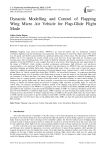
Dynamic Modelling and Control of Flapping Wing Micro Air Vehicle for Flap-Glide Flight Mode
Статья научная
Flapping wing micro-air-vehicles (FWMAV) are micro-air-vehicles that use biomimetic actuation (oscillatory flapping wing) for aerodynamic force generation. The realization of such bionic flight, which offers small size, low speed, and flexible maneuverability has significant military and civilian values. Thus the design of FWMAV (ESB-I) will be very important for security related sectors since they have all the right stuffs for surveillance and reconnaissance. Since everything about a bird is made for flight the kinematic and dynamic modeling as well as control algorithm of bird like FWMAVs is more complex than that of serial robots. Thus balancing the main requirements for the design of FWMAVs which includes excellent aerodynamic performance, high efficiency, and satisfactory maneuverability is very important. With the aim to improve the performance of a FWMAV this work incorporates an intermittent flapping and gliding flight mode. Flap-gliding flight mode, which is often used by large bird species, effectively combines the aerodynamic advantages of fixed and flapping wings. Inspired from it, a kind of flexible flap-gliding Micro Air Vehicle, named Ethio-Smart Bird-I (ESB-I), was successfully designed. An expression describing the mechanical energy cost of travelling of this flight mode in terms of work per range for one flap-glide flight cycle was presented. It is shown that there is an energy saving of flap-gliding flight compared to continuous flapping flight. However due to a system dynamic variation in this flight mode, it possesses difficulty in control surface design. To implement this specific flight mode, this thesis proposes a closed-loop active disturbance rejection control, ADRC, strategy to stabilize the attitude during the processes of flapping flight, transition and gliding flight. To verify the control effect, the unsteady aerodynamic estimation method of the flapping wing based on modified strip theory approach and the dynamics of the FWMAV in Lagrangian form were modelled in the MATLAB/SIMULINK platform and applied in the simulation. Using this model longitudinal stability of ESB-I was analyzed. Simulation results show that even if the FWMAV is in different flight modes, ADRC controller can track the target pitch signal effectively with tracking error less than 0.05rad. To further explain the effects of ADRC in this specific flight mode, the control effects of a PID controller is presented. As per the simulation result ESB-I with PID controller has a target pitch angle tracking error greater than 1rad. This shows that, in flap-gliding flight mode ADRC can track the target pitch signal better than PID controller.
Бесплатно

